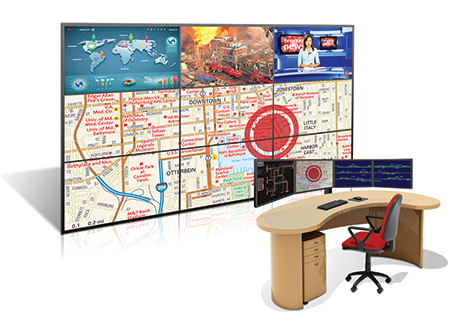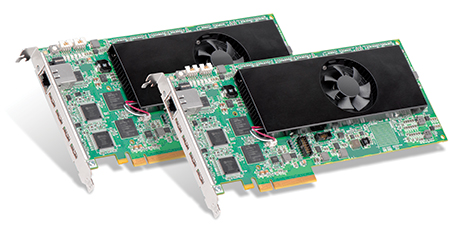Data, communications, and AV are now all transmitted on Internet Protocol (IP) infrastructures. While there are still mission-critical applications that require dedicated hardwired or over-the-air transmission and switching over dedicated connectivity, there are few frontiers that have not been conquered by the relentless advance of IP. Data (text) had the smallest bandwidth footprint and was the first application to be captured, extended, and switched cheaply over global distances. Voice (audio) came next. And video has been the most demanding application to stream across IP networks because of the sheer amount of data involved on the finite bandwidth of IP infrastructures. But evolving infrastructures combined with evolving techniques for moving video have overcome almost all challenges except for perhaps a few holdouts.
When the AV industry began the long and painful overhaul of its Standard Definition (SD resolution) extension and switching backbones cost-effective encoding of HD only appeared in the last third of this ten-year transition. Now that the market is poised to migrate from HD to 4K the transition time will be cut almost in half. And the ability to comfortably move 4K around over IP is available at the beginning of the transition. Netflix today streams 4K content at 15mb/s. So resolution is no longer an issue since encoding effectiveness has now outpaced both content and end point adoption.
It is now possible to transmit video with zero compression to the color space – even in low bit rates. This is particularly useful to high frequency applications like compressed and streamed PC graphics. In electric power SCADA and HMI systems this means that information with fine details – including lines only one pixel thick – can be recorded or streamed with visual integrity.
Distance and cost-effective extension and switching have been breached by audio-video over IP as has stream density for mass distribution.
It’s no surprise that having all text, audio, and video/ graphics information now living on the same medium that the applications for this convergence are providing value in just about all enterprise, government, industrial, entertainment, and residential applications.

The emergence of AV over IP has opened up many useful applications for the electric power industry including the ability to safely share operator data between multi-monitor operator workstations and even a collaborative video wall (as pictured), or record entire operator shifts to network storage (NAS) for training, review, liability, and more.
In the electric power industry several trends are already deeply engaged.
Video enhances decision-making. Seeing an alarm on an electric grid SCADA monitoring system provides information to an operator that ‘something wrong.’ The two possibilities are usually:
- A faulty sensor
- An actual problem that needs intervention
What if an IP camera is at the node that is producing an alarm condition? If an operator can view a camera at that location it is possible to add ‘what is the problem’ to the alarm prioritization decision making process.
Seeing that camera doesn’t come with the same threats and hurdles as many still perceive. There are products on the market today that allow data from a ‘camera’ (or AV) network to live on different cables and switches than IP networks of the critical operator workstations and servers connected to the field of PLCs. While ‘both’ AV and IT information can be available on the same operator displays, it is still possible to have separate IP networks feeding both types of visual information to human operators. The separate networks can be managed together or discreetly – including different user permission levels if required.
The same technology that can be used to ‘decode and display’ AV information on operator workstations can also be used to ‘capture, encode, and stream’ the graphics information from an operator. This too opens up many useful applications.
Quality compression of user graphics data makes it possible to cost-effectively store operator shifts to network storage (NAS). Even multi-monitor workstations can be recorded in their entirety if required.
Since it is possible to encode, decode, and display from the same equipment and over standard IP, it is possible to create generic training systems that work agnostically across multiple different software platforms. It is no longer necessary to have different recipes for recorded SCADA operations versus Microsoft Office or browser-based applications. Productivity apps, GIS, SCADA, CAD, etc. can all be streamed or recorded together. By being able to decode and display AV information from NAS without touching a real data network at all, operators can retrieve stored training files safely even in live environments.

Matrox Mura IPX 4K capture and IP encoder/decoder cards feature an on-board network interface controller (NIC) allowing utilities and public safety operators to work off a separate, AV-dedicated network and securely add drone views, IP cameras, recordings from network storage, live desktop captures, etc., onto a video wall or workstation—with zero impact on the host system.
Operators’ capabilities in a control room or across control rooms at different locations can be further enhanced by sharing data between operators. Again: using entirely different switches and cables than real data networks, it is possible for operators to see each other’s work based on real-time encoding and streaming. This improvement in context and decision-making acuity has tangible benefits to maximizing operator effectiveness.
The same technology makes PC graphics information available ‘across’ functions in an organization. Supervisors can switch from one operator station to the next to keep an eye on many different interfaces including several at once if required.
Evolving standards are also gradually making it easier to share protected content over IP networks. HDCP 2.1 contains improving flexibility towards “interface independent” sharing of protected content – including over standard Ethernet. These evolutions can help improve how government and industry is served by allowing serious data networks to be combined with things such as broadcast television on the same operator displays. This can make news and weather more comfortably accessible to control room operators and start removing the need for separate television infrastructures to support operators in their functions.
And last but not least we must consider some never-before-used or at minimum previously ultra niche capabilities opened up by convergence over IP technologies. Drones is a hot topic for example. Services are now coming into the market to offer utilities and public safety operators low altitude camera views. This could transform myriad functions including diagnosing hard-to-reach locations for outage repairs all the way to monitoring trees and vegetation near overhead powerlines.
The sudden availability of these new form-factors of camera-over-IP data are producing instant hybrid use cases for camera video information from drones combined with graphics information (say GIS maps corresponding to the “locations” of the drones) from PCs. Some operators wish to merge the video footage with the graphics data with real-time encoding so that the information can be streamed as a single (hybrid) ‘video’ stream which can be accessed by multiple people at once on any device from laptops to handheld devices, etc.
Video processing capabilities also offer capabilities to enhance these converged video/graphics capabilities. By providing varying levels of transparency on airborne footage from cameras and super-imposing that on GIS maps, it might soon be possible to have GPS-like capabilities that lead directly to an outage point literally visible on your GPS display.
While some of these ideas may still sound exotic right now for the average transmission and distribution operator, one thing that cannot be denied is that technologies from the consumer electronics and PC markets have produced overwhelming new cost efficiencies for greatly improved access to decision-enhancing visual information through advances in technologies offering capture, encoding, streaming, recording, video processing, multicasting, decoding, display, and switching over standard IP.
About the Author
 Samuel Recine has worked in the high-tech industry for the last twenty years in the areas of sales, product management, and business development. He is currently the Sales Director for Americas and Asia Pacific at Matrox Graphics Inc. Samuel has occupied the position of product manager for high-performance KVM extension products and multi-monitor graphics enablement for remote protocols used on thin-clients and PCs. Samuel has worked closely with solution providers in electric power, transportation, dispatch, security, financial services, and process control, as well as with the Pro A/V channel. Currently Samuel is helping to train OEMs, systems integrators, and VARs in the market and helping to evangelize AV-over-IP for 4K infrastructure by working closely with providers of video walls, multiviewers, KVM extenders, encoders, decoders, transcoders, and video/graphics recording solutions.
Samuel Recine has worked in the high-tech industry for the last twenty years in the areas of sales, product management, and business development. He is currently the Sales Director for Americas and Asia Pacific at Matrox Graphics Inc. Samuel has occupied the position of product manager for high-performance KVM extension products and multi-monitor graphics enablement for remote protocols used on thin-clients and PCs. Samuel has worked closely with solution providers in electric power, transportation, dispatch, security, financial services, and process control, as well as with the Pro A/V channel. Currently Samuel is helping to train OEMs, systems integrators, and VARs in the market and helping to evangelize AV-over-IP for 4K infrastructure by working closely with providers of video walls, multiviewers, KVM extenders, encoders, decoders, transcoders, and video/graphics recording solutions.







